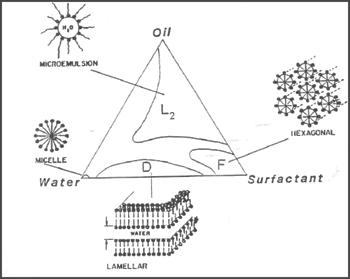| 2003 |

|
YEAR BOOK |
Waterford Institute of Technology
|
Department of Chemical and Life Sciences
|
Separation Science Research Group (SSRG)
Separation science involves the use of techniques to facilitate the isolation, purification and analysis of mixtures. Separation techniques are of importance to a range of industries - including the pharmaceutical, food and biotechnology sectors, as well as in the forensic science, healthcare, environmental science and law enforcement areas.
Establishment of the SSRG was facilitated by the group successfully competing for funding under the Technology Sector Research Strand III initiative. Support was also received for the SSRG from a number of international pharmaceutical companies. Currently eight staff members and six postgraduates are involved in SSRG activities.
Contact: Dr Peter McLoughlin; Tel: 051 302056;
E-mail: [email protected]
Polymer Modified Sensing Group
This multidisciplinary research team investigates the potential of various polymer facilitated sensing methodologies. Use of polymer modified ATR/FTIR (Attenuated total reflectance/Fourier transform infra red) spectroscopy for the detection of residual solvents in the environment is under investigation. Both liquid and gas samples are studied with a view to identifying key factors affecting the diffusion of target analytes into polymer matrices. Chemical investigations coupled with mathematical models are utilised to quantify key diffusion parameters.
A number of peer-reviewed publications have appeared as a result of the activities of this research group. Academic partners based in other Irish and European Universities are actively engaged in collaborative projects with this group.
Contact: Dr Peter McLoughlin; Tel: 051 302056;
E-mail: [email protected]
Surface and Interfacial Chemistry Group
The Surface and Interfacial Chemistry Group is involved in a wide range of research activities from applied to basic, in collaboration with industry and with national and international universities and research institutes in the area of Interfacial Chemistry. Funding has been secured through the Irish Research Council, Higher Education Authority, Enterprise Ireland and the EU CRAFT programme.
One of the areas of interest of the group is the study of the application of associated surfactant structures as reaction media, whereby the control of particle size of the product is governed by the size of the surfactant structure formed. The control of these crystallisation processes is becoming increasingly important in industries such as the electronics industry, where sub micron, uniformly sized particles are required, and the pharmaceutical industry, where different crystal forms of a drug can exhibit very different pharmaceutical activity.

The fundamental properties of the surfactant system have been studied using laser diffraction, contact angle and surface tension meters and low angle X-ray diffraction. The product formed has been analysed by Scanning Electron Microscopy with Elemental Analysis and X-ray diffraction.
Work to date has indicated that this method of particle production has advantages over reaction in bulk media in terms of yield of product, rate of reaction, size control and purity of product.
Contact: Dr Sheila Donegan; E-mail: [email protected]
Macular Pigment and Age-Related Macular Degeneration
Age related macular degeneration (AMD), which damages central vision, is the late stage of age related maculopathy (ARM), and is the leading cause of blind registration in the Western World. The macula, located at the centre of the retina, is responsible for central vision. There exists at the macula a yellow pigment, known as macular pigment (MP), which is composed of the two hydroxy-carotenoids, lutein (L) and zeaxanthin (Z), which are entirely of dietary origin. MP is a powerful antioxidant, and, furthermore, absorbs blue light.
This study, funded by Fighting Blindness, is recruiting 800 healthy volunteers and aims to establish the relationships between MP optical density, serum concentrations of lutein (L) and zeaxanthin (Z), and dietary intake of these carotenoids. Analysis of the results will also examine whether a confirmed family history of ARM/AMD affects these relationships, or whether healthy subjects with high putative risk for the condition have less MP than individuals at no such risk.
Contact: John Nolan(1), Stephen Beatty(2), & Orla O'Donovan(1); (1)Waterford Institute of Technology; (2)Waterford Regional Hospital;
E-mail: [email protected] ; [email protected]
Molecular Ecology
Dr Peter Turner, Dr Catherine O'Reilly and Mr Mark Statham are using DNA analysis to study a pine marten population in a Coillte managed forest at Portlaw, Co. Waterford. The pine marten (Martes martes) is a member of the family Mustelidae which in Ireland also includes the otter, stoat, badger and the introduced American mink.
The pine martin's preferred habitat is mixed forest, although coniferous forest is also used. Its presence in an area is a good indicator of healthy biodiversity in a forest. The pine marten is very shy and therefore rarely seen, and its presence is usually determined by examining faecal droppings (known as scats). Published evidence suggests that such identification can often be wrong. At WIT, DNA analysis of scats and hair samples is being successfully used for species identification of samples using the mitochondrial D-loop sequence, and zfx/zfy alleles are being used for sexing of samples.
Contact: Dr Peter Turner; E-mail: [email protected]
Nitrile/cyanide metabolism by microbes
Inorganic cyanide (HCN) and nitrile (organic cyanides RCN) are produced naturally by many organisms, particularly by plants, and are widely used in by a variety of industries. At WIT, the group led by Dr Catherine O'Reilly is working on the metabolism of nitrites and cyanide by microorganisms.
The work involves isolation of novel cyanide and nitrites metabolizing organisms and identification of the cyanide/nitrile metabolizing pathways. The genes encoding key enzymes involved in cyanide/nitrile metabolism have been isolated and analysed from a number of bacterial and fungal species. Expression of these genes at a high level has been achieved in E. coli and the use of these enzymes for the bioremediation/ biotransformation of cyanide/nitrile is being investigated.
Contact: Dr Catherine O'Reilly; E-mail: [email protected]